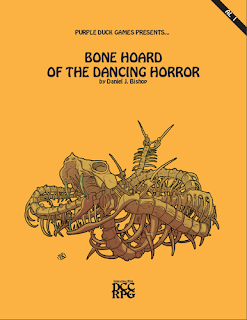Underworld Kingdom, Volumes #1-3 (2013, 2015)
by Albert Rakowski
Self-Published
Three thin booklets at 20 to 36
pages, using the “supplemental grab-bag” model to present a homebrew setting.
The Underworld Kingdom feels most like a published collection of blog posts,
and doesn’t try to provide a coherent or systematic overview of its subject.
This was done successfully in the older and even thinner Towers of Krshal, while the results are less impressive here.
Perhaps this is so because the materials are so disparate (they come from a
long period between 1997 and the publication date, and it shows), or because
some kind of unifying element or hook is missing.
 |
| Underworld Kingdom, Vol. 3 |
There are three booklets, one
dealing with character options, one with gods and spells, and a third with
monsters and magic items. The content follows a general D&D-compatible
format, which would be easy to adapt to any OSR system. There are character
options (e.g. tech levels, social classes, rules for playing the “dead ones” or
dimensional/planetary travellers). This is the collection’s weakest section;
the ideas are general and the execution remains on the surface level, without
adding a genuinely intriguing spin. Length is a factor here. Brevity is the
soul of wit, but here, the lack of additional thought leads to a feeling of barrenness.
The tech level rule determines the kind of tools and items your character can
use, influences starting money, and there is an expanded equipment list classified
by TL, but that is all the booklet does with the concept. These are the kind of
optional rules and random tables which are very common on blogs (“see, I’ve got
this idea about...”), and if it wasn’t for the subject matter (weird
technological fantasy), they would be entirely forgettable. This is, for lack
of a better term, “lazy weird”.
The series improves with the
second and third volumes. The Underworld Kingdom’s thirteen main gods are a dark
and forbidding lot, and their peculiarities are presented in a game-friendly
format. We learn about their dogmas, the kind of blessings and rewards they
confer on believers, the curses they lay on the unfaithful, and even the
miraculous signs they provide. This is a list of grim and even more grim folks
like the Cockroach King (who can give you the power to digest even the foulest
nourishment, but infect you with parasites if you don’t watch out), or Ctuar, a
keeper of gates and secrets whose followers must never go first in a passage
and never leave an opened door behind them. These are good ideas, although
sometimes, the thought that comes to your mind is “screw this repulsive and
thoroughly reprehensible lot”. I like flawed and questionable deities like
anyone else, but sometimes it is just a bit too much. These guys try too hard,
especially when we add the Cthulhu mythos (who are also active here) or the
several minor deities, who are from the same general mould. The recently
reviewed Yngarr’s gods were perhaps
more fanciful and diverse, with a hint of genuine strangeness to them – here it
is all grim, grim and even more grim. Since the new monsters and magic items
also fit the same Metal Album Cover mould, with rune-covered rusty evil
soul-killing stuff smeared with blood and stuff, it can be tiresome when taken
together.
The majority of the spells are
not particularly good, many of them dealing with machinery in
none-too-interesting ways (you can use a spell to recharge them, or control
them, or kill them digitally), dealing in necromantic gruesomeness, or being
simple elementary damage / environmental effects. There are a few neat
exceptions, which are however very high-level, and out of the reach of most
parties, or tied to specific gods (and consequently, super-grim, like Brain Rot
or Maggot Armour).
The monsters and magic items are
perhaps the best part of the collection. They come with interesting imagery, including
deadly fungus, degenerate subterranean dwellers, robots and multiple spider
variants. This imagery does not translate very well to distinct game mechanics,
which would be the next tier on the “good monsters” scale, but if you wish to
populate a dark underworld with vile monstrosities, they are here. The magic
items are varied and imaginative, although this is a rather short and sparse
section that ends all too soon. There are black swords that’d make Elric proud,
a jar of smoke that either lets you extend mental control around you or makes
your targets attack, and so on. This is good.
Underworld Kingdom does not belong to the group of the really
useful utility products (such as the now almost classic Monsters of Myth), while its setting elements are too minor and
scattershot to treat it as a good systematic treatment of its game world (like Towers of Krshal did). Contrary to popular thought, it is not easy
to write either of these product types, and this is just one of the many
attempts that didn’t succeed, or at least it doesn’t have enough of the things
where it does (mostly the sections with a strong flavour of the Underworld
Kingdom setting). They are a catalogue you can leaf through and where you can
find decent ideas, and for that, they are not a bad bargain in PDF. But when it
comes to the print version, you can spend your money more wisely.
Rating: ** / *****

















